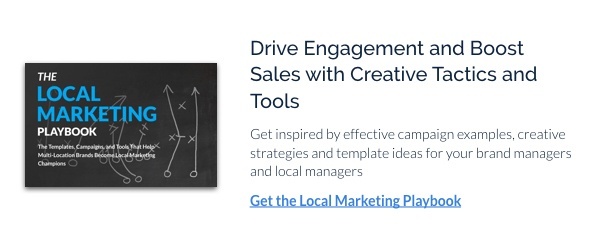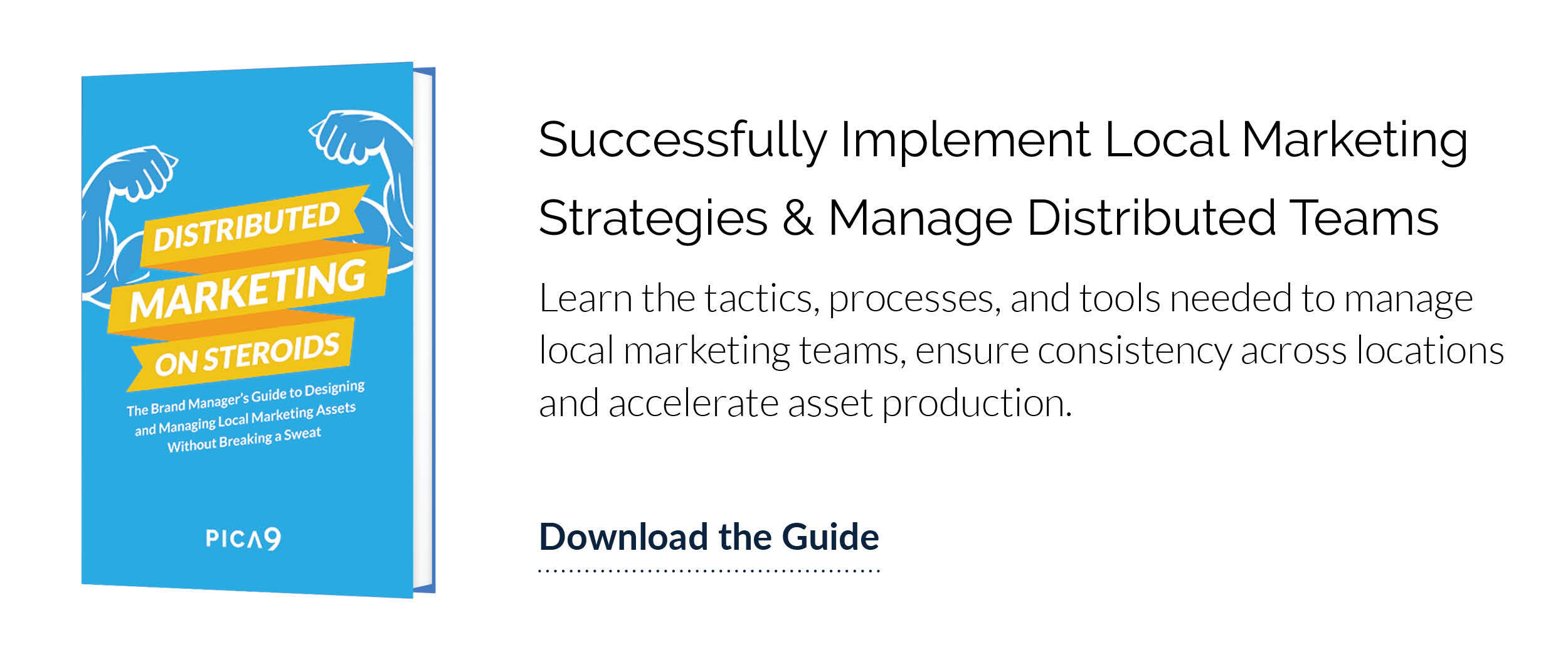At some point, brand managers will probably be faced with an uncomfortable question: why isn't my distributed brand growing as quickly as it could be? It's a question that plagues even the most successful distributed brands. Unfortunately, there isn't a one-size-fits-all formula for achieving rapid growth. Inexperience with marketing at the local level, a lack of tools and resources to build creative assets, and an inconsistent customer experience are just a few elements that can combine to stifle growth. To further complicate things, building a brand that's spread out over many different locations is different from growing just any company. Brand managers are tasked with overseeing distributed marketing across all the branches of the distributed network. When things get busy at HQ, it can be difficult to give local partners the time and attention they need. Additionally, different places will require different strategies to engage the local consumer. Local marketers have a more intimate understanding of this local marketing landscape – a theme that has shown up often in recent studies. But if franchisees, dealers or local sales agents aren't able to do marketing that fits into the brand's strategy, a whole host of growth-stopping problems can show up:
- Misalignment between corporate and local entities
- Duplicated design and marketing efforts
- Failure to comply with established brand standards and guidelines
Why should growth matter so much to brand managers in the first place? It's actually not all that straightforward for many marketers, since as the brand grows challenges like the ones above often do as well.
But there are key reasons brand managers should be excited about growing their brand. First, growth is what gives marketers a better platform on which to distribute their message and connect with customers. If you have more locations you have more opportunities to reach your customers. You also give potential customers a reason to pay attention to your brand – your locations can actually be the best kind of advertising you can get. And of course, growth means increased revenue streams and the boost in marketing budget that can come with it.
So if you're all on board the growth train, you'll probably wonder what you can do to help your brand grow even faster. Let's explore some key reasons why your brand might not be growing quite like you want it to.
Why Your Distributed Brand Isn't Growing Fast Enough
#1: Operating Without a Localized Plan
For any growth-oriented distributed brand, the business goals and corporate mission define the identity of the organization. With more consumers looking for a consistent and personalized marketing experience with the brands they buy from, the goals and mission that get defined at the home office have to expand out to all the local affiliates.
But what's the way to get these goals and missions to show up at each local storefront? Many successful brands are setting out to create highly-localized campaigns that will feel more relevant to consumers. Localized marketing like this is specially designed to build more trustworthy and memorable experiences for consumers. Even high profile brands such as McDonald's and Coca-Cola are seeing the value in creating more localized and personalized customer experiences. In fact, over the next year, the focus on localized campaigns is expected to grow, with analysts at BIA/Kelsey anticipating that local advertising revenues will reach $148.8 billion.
So what's holding so many other brands back from capitalizing on this trend to "go local?" Too often it just comes down to not having the time to make a proper plan for campaigns like these. National branding and other big-ticket marketing items can take priority over smaller-scale campaigns when marketers do their quarterly strategy sessions. But if that happens often enough, it means that marketers are leaving localized marketing basically up to chance.
Solution: In order to build a localized marketing plan that you can actually stick to, you need to define the right responsibilities to give your local partners and affiliates. Marketers should decide how they can give local partners the knowledge (about business goals and objectives) and resources to deliver some of their own localized marketing campaigns. That's a surefire way to continue on a positive growth trajectory even without having to take on more work at HQ.
#2: Targeting the Wrong Local Audiences
Focusing on the wrong customer can cripple growth. There's nothing worse than building marketing material to target an audience that, in your mind, aligns with the product(s) and/or service(s) that you're offering only to realize that the messaging completely missed the mark.
If messaging doesn't connect in a given local market, you can bet that your local affiliates in that region are going to struggle with their sales numbers and more. When this happens, the risks to growth are huge.
To get ahead of a potential misalignment in messaging, brands need to work closely with their local partners to understand what makes customers in their local trade areas unique. You can't always manage this totally at HQ. It can be really difficult to identify what's important about those local consumers, as corporate teams aren't in contact with them day-to-day. Additionally, brand teams often don't have visibility into how those customers have responded to different campaigns and marketing pieces that circulated in a given market. You need to gather feedback from your local partners so you can understand this even better.
Solution: To identify the right audience, use the data you can get about customer purchasing habits and more. Get some on-the-ground insight from local partners by asking them to help identify who your local audience really is and what they value or what makes them unique. Then tailor your marketing activities to deliver on that unique profile. You might even evolve your marketing personas based on the feedback you collect.
#3: Non-Compliant Local Partners
How does compliance from your local affiliates influence growth? Non-compliance at the local level disrupts consistencies between the national and local brand, diminishes the customer experience and tarnishes brand equity in the long run. When local partners take it upon themselves to create their own marketing materials, they often go outside the bounds of what's been approved by corporate. Required disclosures and design rules set forth by corporate marketing teams can be totally missed. As a result, brands and their local partners often get into a tedious back-and-forth about reconfiguring marketing materials so they adhere to established brand standards and guidelines. These unnecessary roadblocks obviously hurt growth. Your local affiliates could end up spending more time negotiating with corporate than actually getting their jobs done!
Solution: Corporate marketing teams must enable local affiliates to comply with brand standards by providing access to assets and templates. With Local Marketing Automation platforms like CampaignDrive, local marketers have ready-access to pre-approved and compliant marketing materials.
#4: Failure to Collaborate
Due to a lack of experience in marketing, local affiliates often don't know what good distributed marketing actually looks like. In fact, 81 percent of distributed brands report that local partners don't have much experience when it comes to marketing, graphic design or technology. They probably have a few ideas on what marketing channels might be effective, but lack the concrete data to support those assumptions. If the local partner doesn't truly understand what good or bad marketing looks like, they are less likely to run a successful marketing campaign at the local level. Without quality marketing for their local store, they're going to struggle to grow their sales and your brand will struggle to add locations.
Solution: Corporate marketing teams must share local marketing wins with the whole network. If a location in Pennsylvania is nailing the recent brand campaign, give other locations the insight needed to deliver those same results. Take the guesswork out of marketing by giving them the top three most effective marketing channels and provide best-use strategies for each. Get the regional team to talk to local partners — what's working and what's not working for them? Take every precautionary step you can to get ahead of your local partners' most frequent questions or concerns and give them solutions needed to tackle local marketing right.
#5: Outdated MarTech
There are a number of technological bottlenecks that can hold brands back. Recent research revealed that 95 percent of corporate brands currently use some kind of Local Marketing Automation (LMA) capabilities to support corporate and local marketing communications. However, the research goes on to suggest that when those systems are totally custom or were built in-house, they fail to deliver a meaningful return on the amount of investment they require.
To try and support the distributed brand's wide range of marketing activities, many marketers end up over-investing in overlapping marketing technologies with redundant functionality that doesn't get used. Without having a centralized platform for local marketing communications, data often gets siloed and marketing misalignment is likely to occur. Unfortunately, when using outdated systems that haven't been engineered to deliver the critical capabilities that support today's distributed networks, these problems are even more common.
Solution: Brands should try to adopt brand management systems that are geared towards helping local marketers achieve exceptional marketing results. These modern tools enable distributed brands to achieve superior operational efficiency while consolidating outdated legacy tools. These types of solutions save brands valuable time, energy and money.
Give Local Partners the Tools to Succeed
Are you ready to ignite your path towards business growth? Operating without a localized plan, targeting the wrong audience, non-compliant local partners, failure to collaborate and outdated technology are just a few of the barriers brands must overcome to achieve their maximum growth velocity.
The most successful distributed brands use Local Marketing Automation solutions to unlock powerful growth opportunities. With access to easy-to-use templates that automatically activate brand standards and guidelines, local partners can deliver their best work. Additionally, distributed marketing management solutions like these prevent the use of non-standard typefaces and colors, configure and apply legal disclaimers and disclosures automatically and prevent the non-compliant use of logos and other design elements.
The main takeaway? When corporate marketing teams and local partners have the tools they need to stay in sync, growth is guaranteed!
Equip your local marketers with best-practice strategies to help your distributed brand grow. Download The Local Marketing Playbook: The Templates, Campaigns, and Tools That Help Multi-Location Brands Become Local Marketing Champions. 

